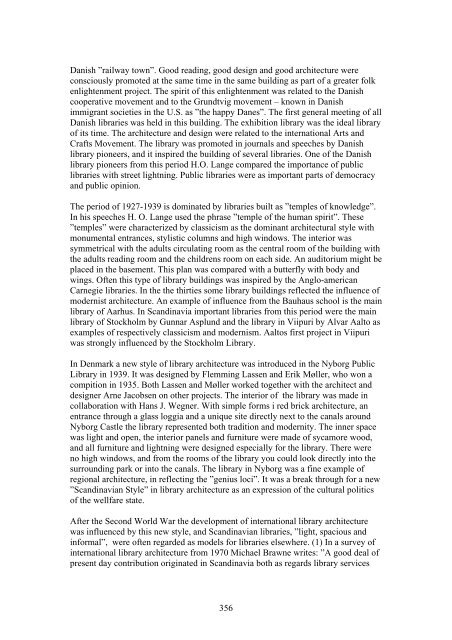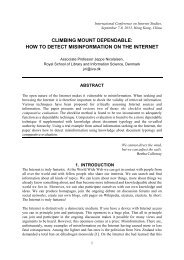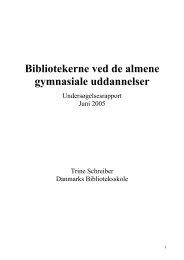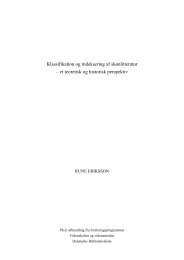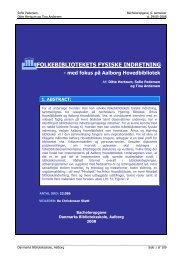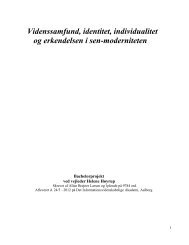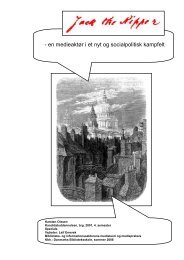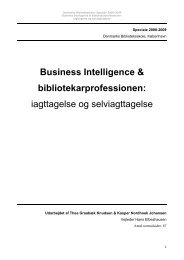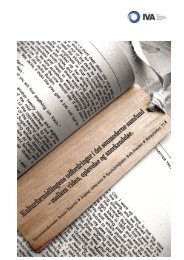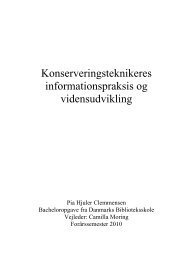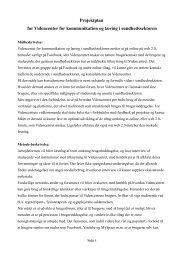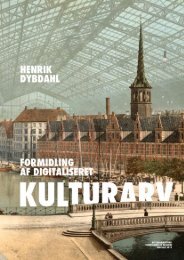- Page 1:
ÅBNINGEN AF BIBLIOTEKSRUMMET - DE
- Page 4 and 5:
CIP - Cataloguing in Publication Da
- Page 6 and 7:
BIBLIOTEKET SOM VIDENSTEMPEL. KLASS
- Page 8 and 9:
Tak til Jens Fleischer fra Københa
- Page 10 and 11:
forskningsbiblioteker, som ligelede
- Page 12 and 13:
IAGTTAGELSER, UDGANGSPUNKT OG PROBL
- Page 14 and 15:
FORSKNINGSOVERSIGT Bygningstyper og
- Page 16 and 17:
seks bind i 1979-80 af forlaget Gyl
- Page 18 and 19:
Heller ikke for skolebygningernes v
- Page 20 and 21:
på at støtte deres fortsatte eksi
- Page 22 and 23:
ygning er det formen og materialern
- Page 24 and 25:
Bogens tre hovedafsnit har de karak
- Page 26 and 27:
hjemmets dagligstue” sagde Danmar
- Page 28 and 29:
diskuteres forskellige baggrundsfak
- Page 30 and 31:
andre offentlige rum, og hvordan vi
- Page 32 and 33:
Adgangen til de mange kulturelle in
- Page 34 and 35:
ordnet alfabetisk efter forfatterne
- Page 36 and 37:
Hvad kulturen øges med via special
- Page 38 and 39:
evægelses opfattelse af åbne, fly
- Page 40 and 41:
tradtionen og en ”sentimentaliser
- Page 42 and 43:
Kunsthistorikeren Lise Bek har besk
- Page 44 and 45:
Helt centralt for undersøgelsen er
- Page 46 and 47:
f.eks. skoler eller bygninger som f
- Page 48 and 49:
Timgad fra ca. 100 e. Kr. med bibli
- Page 50 and 51:
I renæssancen skete der som allere
- Page 52 and 53:
Liberihuset som en del af det davæ
- Page 54 and 55:
Det kongelige Biblioteks oprindelig
- Page 56 and 57:
Læsehjul som praktisk hjælpemidde
- Page 58 and 59:
Boullées biblioteksvision fra 1785
- Page 60 and 61:
Oplysningsarkitekturen var således
- Page 62 and 63:
Durands geometriske og panoptiske b
- Page 64 and 65:
Den franske filosof og kulturhistor
- Page 66 and 67:
Aperuit: Han åbnede det. Videnstem
- Page 68 and 69:
Leopoldo della Santas plan fra 1816
- Page 70 and 71:
Ligesom Labrouste var optaget af bi
- Page 72 and 73:
De panoptiske læsesale i British M
- Page 74 and 75:
Den angelsaksiske biblioteksudvikli
- Page 76 and 77:
Boston Public Library inspireret Bi
- Page 78 and 79:
utale konglomerat, dette krasse, gr
- Page 80 and 81:
sammenligning med f.eks. samtidens
- Page 82 and 83:
Förenta Stater (59). Steenbergs da
- Page 84 and 85:
San Pietro Martire i Verona. Akvare
- Page 86 and 87:
College Library fra 1733 i Dublin o
- Page 88 and 89:
Statsbiblioteket i sne. Til kommiss
- Page 90 and 91:
Lysekronene var udformet som insekt
- Page 92 and 93:
Tværsnit med oktogon. Hovedfacade
- Page 94 and 95:
Den basilicaformede læsesal med se
- Page 96 and 97:
Samme monumentale præg havde perio
- Page 98 and 99:
Læsestue med gasbelysning i køben
- Page 100 and 101:
deres benyttelse. Læseselskaberne
- Page 102 and 103:
Læsestuen i Amagertorv 6 med lyse
- Page 104 and 105:
Plan over Lægeforeningens Boliger
- Page 106 and 107:
I købstæderne og på landet var f
- Page 108 and 109:
skrifter og udgav vejledende bogfor
- Page 110 and 111:
Fotografi af Stationsbyudstillingen
- Page 112 and 113:
kompleksiteten i storbylivet: På d
- Page 114 and 115:
Brandes og ”det moderne gennembru
- Page 116 and 117:
Til de mange folkeoplysende projekt
- Page 118 and 119:
Mellemkrigstidens kulturradikale st
- Page 120 and 121:
frem for asylerne, at den ikke er s
- Page 122 and 123:
Fåborg Museum fra 1912, som blev f
- Page 124 and 125:
afslutningen af 1. Verdenskrig til
- Page 126 and 127:
Fælles for tiernes og tyvernes nyk
- Page 128 and 129:
og udvikling, herunder biblioteksby
- Page 130 and 131:
Bibliotekstilsynets retningslinier
- Page 132 and 133:
ufarlig: ”Men een Ting kan i hver
- Page 134 and 135:
iblioteksbyggeriet i Danmark i det
- Page 136 and 137:
Askov Højskole. Byggeprogrammet bl
- Page 138 and 139:
Avislæsesalen i Kvindelig Læsefor
- Page 140 and 141:
De unges Læsestue i Århus fra 192
- Page 142 and 143:
Universitetsbibliotekets nye bygnin
- Page 144 and 145:
Tegning af et moderne amerikansk bi
- Page 146 and 147:
Universitetsbibliotekets bogtårn e
- Page 148 and 149:
Det indre af Det Deichmanske Biblio
- Page 150 and 151:
Asplunds oprindelige forslag fra 19
- Page 152 and 153:
Stadsbiblioteket i Stockholm. Forsl
- Page 154 and 155:
På grund af bibliotekets eksklusiv
- Page 156 and 157:
Aaltos inspirationsskitse til det i
- Page 158 and 159:
Foredragssalen med bølgeformet tr
- Page 160 and 161:
Los Angeles Public Library fra 1926
- Page 162 and 163:
Bibliotek i Sandleitenhof med skran
- Page 164 and 165:
Leonidovs biblioteksmodel fra 1927.
- Page 166 and 167:
kassetterede lofter. Biblioteket, s
- Page 168 and 169:
BIBLIOTEKET SOM HJEM. HISTORISKE ST
- Page 170 and 171:
Køge museum og bibliotek fra 1899.
- Page 172 and 173:
Harald Herdal har i sine biblioteks
- Page 174 and 175:
Læsestue i Ålborg med almuemøble
- Page 176 and 177:
Stuerne, og i denne indtegner jeg n
- Page 178 and 179:
indikatortyper, typer af tidsskrift
- Page 180 and 181:
Appletons Boghandel i New York med
- Page 182 and 183:
Tilsvarende udgangslåge med fodped
- Page 184 and 185:
Udlånet i Griffenfeldsgade på Nø
- Page 186 and 187:
interesser dominerede udstillingen,
- Page 188 and 189:
Grundplan for den vinkelformede bib
- Page 190 and 191:
Fotografi fra udstillingsbiblioteke
- Page 192 and 193:
”Biblioteksorganisme” med bl.a.
- Page 194 and 195:
De fleste stationsbyer var dog alle
- Page 196 and 197:
To ”Stuer” i Vejen Bibliotek me
- Page 198 and 199:
muligt.” Disse hensyn førte til
- Page 200 and 201:
Carl Jørgensen fik i den efterføl
- Page 202 and 203:
Principskitse til panoptisk reolops
- Page 204 and 205:
Biblioteker var skilt fra Bøgerne
- Page 206 and 207:
korrespondance, som blev omhyggelig
- Page 208 and 209:
Grundplan for Køge Biblioteks hjem
- Page 210 and 211:
Silkeborg Biblioteks læsesal med g
- Page 212 and 213:
I 1916 indrettedes der børnelæses
- Page 214 and 215:
Svendborg By og Amts Bibliotek blev
- Page 216 and 217:
I Bogens Verden havde Steenberg en
- Page 218 and 219:
voksenlæsesalen. I fløjen til ven
- Page 220 and 221:
Sønderborg Bibliotek som gavlhus i
- Page 222 and 223:
Fornemmere nyindretninger var Slage
- Page 224 and 225:
Folkebiblioteket i Nykøbing Mors b
- Page 226 and 227:
Københavns Hovedbiblioteks læsesa
- Page 228 and 229:
Grundplan for Lemvig Bibliotek. I d
- Page 230 and 231:
Den eneste danske biblioteksbygning
- Page 232 and 233:
etager med udlånet i stuen og læs
- Page 234 and 235:
Jernbanegade, som forbandt den opri
- Page 236 and 237:
I den bageste Stue er Haandbogssaml
- Page 238 and 239:
Aabne Hylder! D.v.s. Laaneren kan s
- Page 240 and 241:
Mønsterbiblioteket i Døcker-Telt
- Page 242 and 243:
landet: ”Tilvejebringelse i Landk
- Page 244 and 245:
Grundplan for Kommunens Forsamlings
- Page 246 and 247:
BIBLIOTEKET SOM VIDENSTEMPEL. KLASS
- Page 248 and 249:
centrale kortkartotek. Voksenudlån
- Page 250 and 251:
i høj grad tale om påvirkning fra
- Page 252 and 253:
der var flankeret af to lamper og t
- Page 254 and 255:
Udsmykning i læsesalen med Larsens
- Page 256 and 257:
Frederiksberg Bibliotek med oprinde
- Page 258 and 259:
Facaden var symmetrisk omkring et i
- Page 260 and 261:
Læsesalene havde ca. 100 pladser o
- Page 262 and 263:
Kolding Bibliotek med balkonetage.
- Page 264 and 265:
lå udlånssalen og udlånssalens f
- Page 266 and 267:
Århus Hovedbibliotek set med klass
- Page 268 and 269:
Plan af stueetagen i omvendt T-form
- Page 270 and 271:
Avislæsesalen i hovedbiblioteket i
- Page 272 and 273:
Plan over Vejle Biblioteks tilnærm
- Page 274 and 275:
Hvidovre Bibliotek. Grundplan for H
- Page 276 and 277:
Thisted Bibliotek. Thisted Bibliote
- Page 278 and 279:
vi nu arbejder efter. De var Udtryk
- Page 280 and 281:
Filialbiblioteket på Vesterbro fra
- Page 282 and 283:
Hernings avislæsestue med blå pol
- Page 284 and 285:
Også tidens arkitekter accepterede
- Page 286 and 287:
Folkebibliotek i Sharon, Massachuse
- Page 288 and 289:
Tinglev Bibliotek. Grundplan af Tin
- Page 290 and 291:
DET ÅBNE BIBLIOTEKSRUM FUNKTIONEL
- Page 292 and 293:
Holm, København med en toetages ho
- Page 294 and 295:
Nyborg Bibliotek fra 1939 på halv
- Page 296 and 297:
praktisk folkeoplysning. Stolene i
- Page 298 and 299:
Biblioteksrummets fortsættelse i b
- Page 300 and 301:
Nyborg Bibliotek har desuden fået
- Page 302 and 303:
I indledningen til den fællesnordi
- Page 304 and 305:
Næsten laboratorieagtig nøgtern i
- Page 306 and 307:
Varde Bibliotek fra 1941med indgang
- Page 308 and 309:
Et enkelt skolestudie i form af Lud
- Page 310 and 311: Byplan for Padborg fra 1923 med pri
- Page 312 and 313: Edvard Thomsens forslag til panopti
- Page 314 and 315: Povl Stegmanns forslag, der vandt k
- Page 316 and 317: Konkurrencens 1. præmie, som den b
- Page 318 and 319: Aage Rafns forslag med høj søjlel
- Page 320 and 321: Det åbne rum i midten af bibliotek
- Page 322 and 323: Arne Jacobsens og Flemming Lassens
- Page 324 and 325: Periodens to afsluttende konkurrenc
- Page 326 and 327: Overordnet kom biblioteksoffentligh
- Page 328 and 329: Forside fra det svenske Folkbibliot
- Page 330 and 331: De historiske stilarter og Skønvir
- Page 332 and 333: heste og ryttere fandt Larsen Stevn
- Page 334 and 335: Niels Bjerre: Udsigt over Lemvig fr
- Page 336 and 337: Jens Søndergaard mellem malerier o
- Page 338 and 339: åde personlige og universelle kara
- Page 340 and 341: Varierede bogbind som i en hjemlig
- Page 342 and 343: Eksempler på tyvernes ex libris me
- Page 344 and 345: I 1937 afholdtes en stor biblioteks
- Page 346 and 347: opført i Køge i 1899 sammen med b
- Page 348 and 349: vægten på det lille samfunds nær
- Page 350 and 351: tilkendegivelser. Modellen skitsere
- Page 352 and 353: Bibliotekets nærhed og enkelhed ku
- Page 354 and 355: museumsbyggeriet prægedes af nykla
- Page 356 and 357: tilsvarende undertiden næsten telt
- Page 358 and 359: Bedre Byggeskik, Klassicisme, nærl
- Page 362 and 363: NOTER INDLEDNING (1) Bogens Verden,
- Page 364 and 365: (58) Døssing, Thomas: Folkebibliot
- Page 366 and 367: (11) Habermas, Jürgen: Teorien om
- Page 368 and 369: (35) Nielsen, Helge: Folkebibliotek
- Page 370 and 371: (110) Hvenegaard Lassen, 1962, s. 6
- Page 372 and 373: (52) Hvenegaard Lassen, 1962, s. 23
- Page 374 and 375: (16) Burgoyne, F.J.: Library Constr
- Page 376 and 377: (71) Bibliotekstilsynets Bekendtgø
- Page 378 and 379: (156) Bogens Verden, 1932, s. 193-1
- Page 380 and 381: (43) Bogens Verden, 1937, s. 81-89
- Page 382 and 383: PROJEKTER OG KONKURRENCER (1) Bjerg
- Page 384 and 385: (19) Døssing, 1924, s. 11. (20) L
- Page 386 and 387: Norberg-Schulz, Christian: Stedskun
- Page 388 and 389: Korsgaard, Ove: Kampen om lyset, K
- Page 390 and 391: Cornell, Elias: Rummet i arkitektur
- Page 392 and 393: Lorenzen, Vilh.: Stationsbyen på L
- Page 394 and 395: Beretning om det 1. almindelige dan
- Page 396 and 397: Skouvig, Laura: ”Bibliotekssagen
- Page 398 and 399: Grønborg, Johannes: Forsamlingsbyg
- Page 400 and 401: ILLUSTRATIONER s. 44 Norberg-Schulz
- Page 402 and 403: s. 174 Ringdal, 1995, s. 121. Ringd
- Page 404 and 405: s. 282 Hadley, 1924, s. 67. s. 283
- Page 407 and 408: Danske folkebiblioteksbygninger 177
- Page 409 and 410: 1869 Skagen ( I præstegården) HHL
- Page 411 and 412:
1897 1898 1899 Køge (Sammen med mu
- Page 413 and 414:
1903 Holstebro (Højskolehjem) Indv
- Page 415 and 416:
1911 Køge (Fattiggård) ”Spindeh
- Page 417 and 418:
1916 Vejen (Villa) Indv. 30/9 1916
- Page 419 and 420:
1919 Thisted (Sammen med adm. bygni
- Page 421 and 422:
1921 Nykøbing M. Studieværelse Ar
- Page 423 and 424:
1922 Store Heddinge BV 1922, s.127
- Page 425 and 426:
1925 Hobro (Sammen med museum) Bibl
- Page 427 and 428:
1927 Hjørring Ark. Konkurrence Ark
- Page 429 and 430:
1930 Nørresundby Bibl. Chr. Lørup
- Page 431 and 432:
1932 Martofte Indv. 13/9 1932 Lære
- Page 433 and 434:
1934 Århus Ark.Konkurrence Indv.29
- Page 435 and 436:
1936 Ulfborg Kirkeby BV 1936, s. 34
- Page 437 and 438:
1938 Vinderup Indv. 25/10 1938 Ark.
- Page 439 and 440:
1940 Gladsaxe Indv. 30/1 1940 Ark.
- Page 441 and 442:
1943 Rudkøbing (Sammen med sygekas
- Page 443 and 444:
WB V s.272 WB V s.417 WB V s.470 WB
- Page 445 and 446:
STEDREGISTER Danske folkebiblioteke
- Page 447 and 448:
Hobro (Hotel) Indv. feb. 1905 7 Hob
- Page 449 and 450:
Ringkøbing 1901 6 Ringkøbing (Sko
- Page 451 and 452:
Åkirkeby 1912 9 Ålborg (Latinskol
- Page 453 and 454:
1775-1898 (124 år) 1899-1904 1905-


